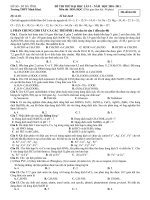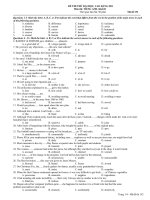bài giảng viruses của đại học SAS
Bạn đang xem bản rút gọn của tài liệu. Xem và tải ngay bản đầy đủ của tài liệu tại đây (2.34 MB, 39 trang )
Viruses &
Viruses &
Bacteria
Bacteria
Chapter 17
Chapter 17
Biology 11
Biology 11
Presentation put together by Mandie
Presentation put together by Mandie
Lynn Walls
Lynn Walls
What are Viruses
A virus is a non-cellular particle made
up of genetic material and protein
that can invade living cells.
T4 Bacteriophage
T4 Bacteriophage
Herpes Virus
Herpes Virus
Escherichia Coli Bacterium
Escherichia Coli Bacterium
E. coli is a bacterium. That is a crude cell, it is not a virus
E. coli is a bacterium. That is a crude cell, it is not a virus
because viruses are protein containers with DNA cores or
because viruses are protein containers with DNA cores or
RNA cores.
RNA cores.
E. Coli and the
E. Coli and the
Bacteriophage
Bacteriophage
What it looks like in real life
What it looks like in real life
The Structure Of a Virus
The Structure Of a Virus
Viruses are composed
Viruses are composed
of a core of nucleic
of a core of nucleic
acid
acid
The Nucleic acid core
The Nucleic acid core
is surrounded by a
is surrounded by a
protein coat called a
protein coat called a
capsid
capsid
The Nucleic core is
The Nucleic core is
either made up of
either made up of
DNA or RNA but never
DNA or RNA but never
both
both
Cycle of Lytic and Lysogenic
Cycle of Lytic and Lysogenic
Vaccines
Vaccines
►
Viruses grown on chicken embryos are
Viruses grown on chicken embryos are
attenuated vaccines
attenuated vaccines
►
Another type of vaccine is made by heat
Another type of vaccine is made by heat
killing the virus
killing the virus
Retrovirus
Change DNA
into RNA.
Example of a
Retrovirus is
HIV
A typical, "minimal"
retrovirus consists of:
•
an outer envelope which
was derived from the plasma
membrane of its host
•
many copies of an envelope
protein embedded in the lipid
bilayer of its envelope
•
a capsid; a protein shell
containing
•
two molecules of RNA and
•
molecules of the enzyme
reverse transcriptase
Bacteria Cell
Prokaryotes
Cells that do not have a
nucleus
Exist almost every where on
earth
Grow in numbers so great you
can see them with the unaided
eye
Are placed in either the
Eubacteria or the
Archebacteria Kingdoms
Make up the smaller of the two
kingdoms
Eubacteria
Eubacteria
Make up the larger of
Make up the larger of
the two prokaryote
the two prokaryote
kingdoms
kingdoms
Generally are
Generally are
surrounded by a cell
surrounded by a cell
wall composed of
wall composed of
complex
complex
carbohydrates
carbohydrates
Cyanobacteria
Cyanobacteria
Photosynthetic
Photosynthetic
bacterium
bacterium
Bluish-greenish color
Bluish-greenish color
Contain membranes
Contain membranes
that carry out the
that carry out the
process of
process of
photosynthesis
photosynthesis
Do not contain the
Do not contain the
same type of
same type of
chloroplasts as plants
chloroplasts as plants
do
do
This bluish-greenish
This bluish-greenish
algae can be found
algae can be found
nearly everywhere on
nearly everywhere on
earth.
earth.
Can survive in
Can survive in
extremely hot
extremely hot
environments and even
environments and even
extremely cold
extremely cold
environment
environment
Archaebacteria
Archaebacteria
Lack important
Lack important
carbohydrate found
carbohydrate found
in cell walls
in cell walls
Have different lipids
Have different lipids
in their cell
in their cell
membrane
membrane
Different types of
Different types of
ribosomes
ribosomes
Very different gene
Very different gene
sequences
sequences
Archaebacteria can
Archaebacteria can
live in extremely
live in extremely
harsh environments
harsh environments
They do not require
They do not require
oxygen and can live
oxygen and can live
in extremely salty
in extremely salty
environments as well
environments as well
as extremely hot
as extremely hot
environments.
environments.
Identifying Prokaryotes
Identifying Prokaryotes
Cell Shape
Cell Shape
Cell Wall
Cell Wall
Movement
Movement
Bacterium Shapes
Cocci~ Sphere shaped
bacteria
Bacillus~ Rod shaped bacteria
Spirrillium ~ Spiral shaped
bacteria
Flagella~ Leg-like structures
that help to propel the
bacterium.
Gram + and Gram – Bacterium
Gram + and Gram – Bacterium
Cell Walls
Cell Walls
Cellular Walls
Cellular Walls
Chemical nature of a cell wall can be determined
Chemical nature of a cell wall can be determined
by Gram Staining
by Gram Staining
By finding out what color the cell produces when
By finding out what color the cell produces when
it is gram stained you can figure out the type of
it is gram stained you can figure out the type of
carbohydrates in the cell wall
carbohydrates in the cell wall
Movement
•
Flagella ~ Tail like structure
the whips around to propel the
bacterium
•
Cillia ~ Miniature flagella
surround the cell that help to
“swim”
•
Non motile ~ Sticky cillia like
structures that keep the
bacterium from moving
Flagella
Flagella
Bacteria and their
Bacteria and their
energy
energy
Autotrophs
Autotrophs
Chemotrophs
Chemotrophs
Heterotrophs
Heterotrophs









